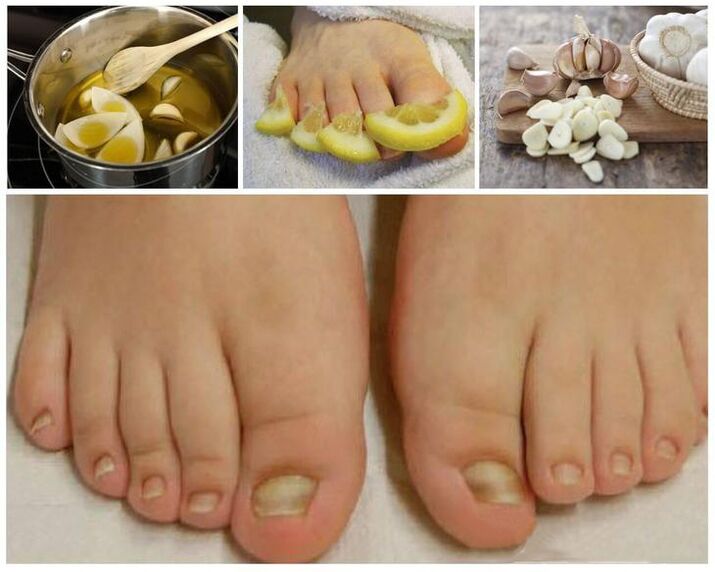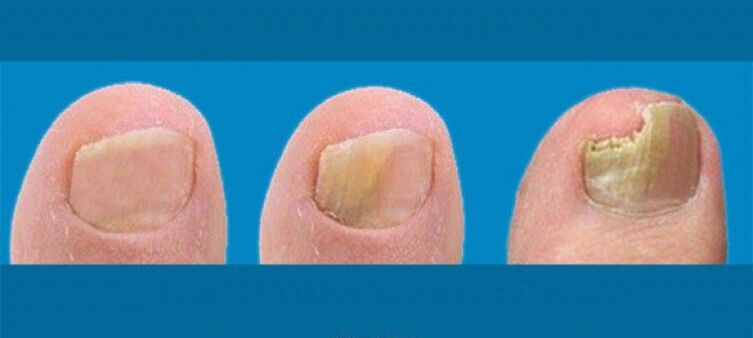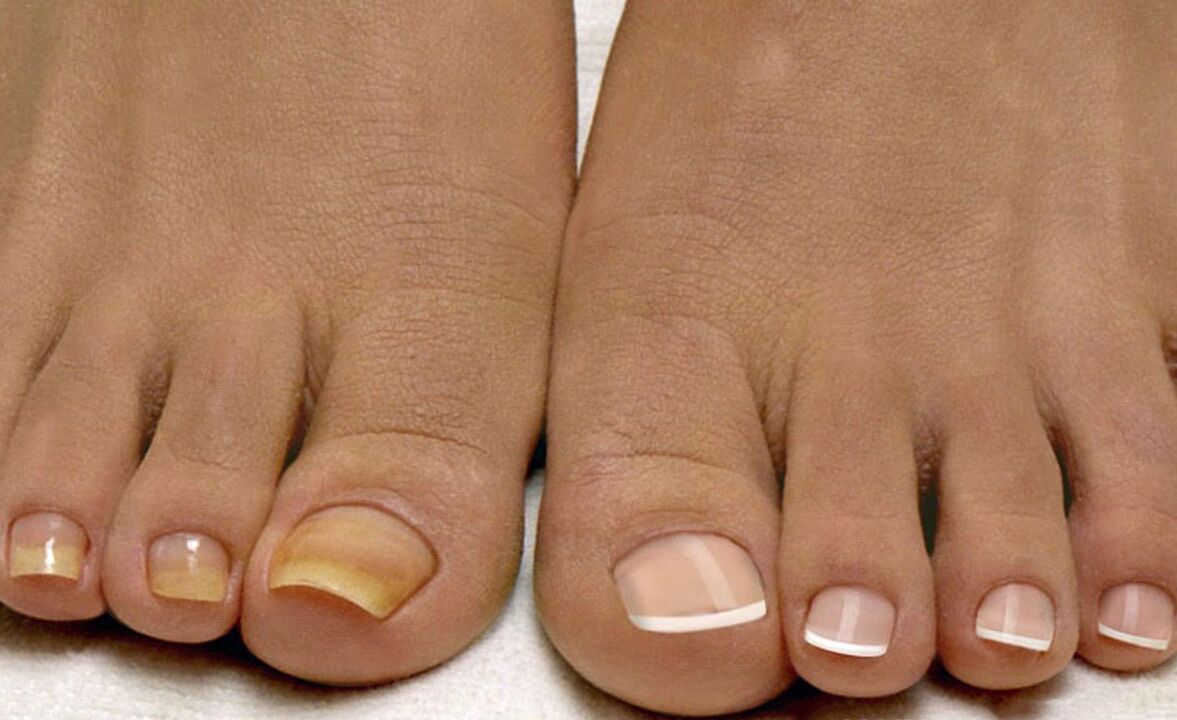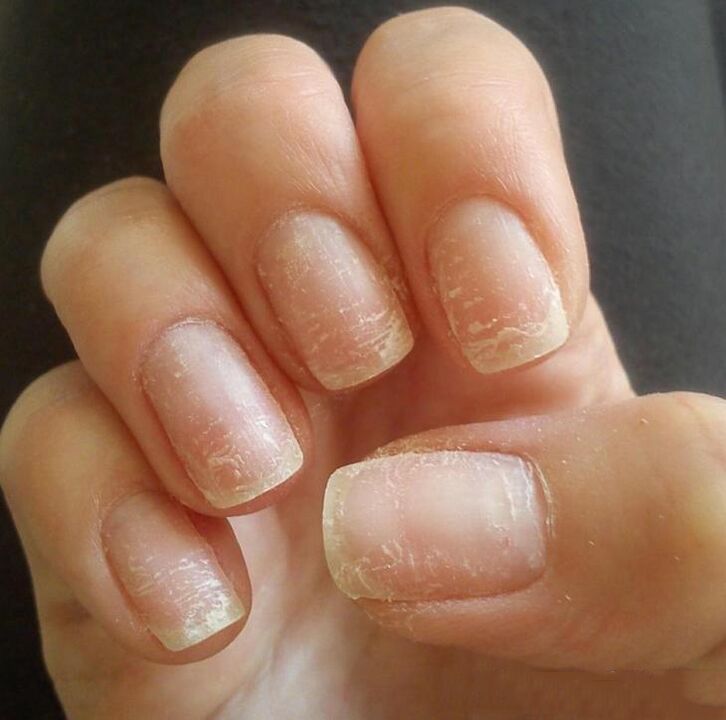
A fungal infection can absolutely affect any part of the body.Fungi, like other bacteria and microorganisms, are always present in the human body and in their skin in a strict balance.When the number of fungi increases for several reasons, an infection can begin.
Onicycosis, also called fungal onichia, is a fungal infection that affects nails on the legs or hands.It develops slowly, so it is very difficult to notice any sign of the disease at the beginning.
Why is it developing?
The fungal infection of the nails begins from the moment the number of fungi inside, below or on the nails increases sharply.Fungi love a warm and humid atmosphere, so during any adequate environment they begin to multiply intensely.The fungus of the nails occurs due to the same fungi that cause limiting eczema, mycosis and lichen of cutting.
Fungi, living quietly and in the body of absolutely anyone, can cause nail infection.If you are in contact with someone who has this disease, it can be transmitted.According to the American Academy of Dermatology, fungal infections often affect leg legs than in the arms, because the fingers are more often in a warm and humid atmosphere.
If you are used to making manicure and pedicures in the cabin, then it is worth discovering how the personnel disinfects the tools and how often do it.Farewells for manicure and pedicure, such as nail files and tapes, can be a source of infection, which in any case, without adequate disinfection, will be transmitted to another person.
Who can get infected?
There are many causes of a fungal infection of the nails, and each of them is treated in their own way.Most of these reasons can naturally be prevented, but there are some factors that significantly increase the risk of this infection.The greatest risk of nail fungus is people who:
- They are ill of diabetes;
- have a disease that weakens blood circulation;
- over 65 years;
- have upper nails;
- Visit public bathrooms, swimming pools;
- have nail injuries;
- They are injured in the skin around the nails;
- The legs are constantly in moisture or constantly sweat;
- have a weak immune system;
- They wear narrow and narrow shoes such as tennis and boots shoes.
A fungal infection is more common in men than in women, and more often in older people than in children.If someone is sick in their family with a fungus, then it is most likely to have it in the future.Older people have the greatest risk of developing this infection, since blood circulation worsens with age, and nails become slower and become thicker.
How do you see the nail fungus?
A fungal infection can affect part of the nail, the complete nail or several nails at the same time.
Visible signals

The explicit symptoms of the nail fungus are:
- Nail stratification, which is called purbal hyperkeratosis;
- White or yellow stripes in the nail, which are called lateral onychomycosis;
- folk or corner, which is called distal onylomycosis;
- Excessive white spots on the nails, after which holes remain;
- the appearance of yellow spots near the nail hole, which is called proximal onychomycosis;
- Loss of nail.
General signals
Common symptoms of fungal infection are considered:
- Deformation of the nail plate, the nail does not stay well in place;
- an unpleasant smell of an infected nail;
- crumbled or thickened nails.
How to find out if I have a nail fungus?
The only way to confirm the diagnosis is to consult a doctor, because some other infections can also affect nails and have symptoms similar to fungus.In such cases, a scraping of the nail is generally taken, which is sent to the laboratory for a detailed analysis and clarification of the diagnosis.
When is the time to see a doctor?

In most cases, nail fungus is considered a purely cosmetic problem.However, in some people, a fungal infection can cause serious complications.Then, in people with diabetes, nail fungus can lead to foot ulcers or other leg problems.According to the 2012 study, a chronic nail fungus on the legs is considered one of the main risk factors and a key condition for the development of bacterial cellulite of the legs.
Therefore, if you have diabetes or a weakened immune system, you should not use home remedies for the treatment of nail fungus.Contact the doctor to get help to find out how to treat the fungus in the legs and how to treat.
How to cure nail fungus on your feet?
Medications on -complex are generally not recommended for the treatment of fungal nail infections, since they do not provide reliable results.Instead, your doctor recipe oral antimicotic medications.These drugs are very effective, but have many side effects of stomach disorder and dizziness with skin problems and jaundice.
You can use other antimicotic agents, such as antimicotic varnish or nail base.It applies to the nail in the same way as the ordinary nail polish.Depending on the type of fungus, as well as the degree of damage to the nail plate, this tool may have to be used for several months.
Unfortunately, treatment does not guarantee that complete fungal infection quickly eliminates.In almost half of the cases, the nail fungus returns again.Complications are not excluded.Perhaps, therefore, many people are more likely to resort to the help of traditional medicine.
Popular fungi remedies
The fungus on the nails of the legs is not at all that he would like to see on his feet, especially in the summer during the beach season.Therefore, we decided to collect the 10 most popular and effective means of traditional medicine to discover how to treat nail fungus on the legs.
Snake Highlander extract

Snake Highlander extract is a natural antimicotic agent.The highlander of the Snake refers to sunflower family plants.A study in 2008 showed that the extract is also effective against the fungus of the nails on the legs, such as a cyclooprox drug prescribed by the recipe.To get rid of fungal infection in the legs with this method, you must adhere to the following scheme: in the first month of treatment, apply an extract to the affected area every third day, in the second month twice a week and within a third month 1 per week.
Tea tree oil
Tea tree oil, also called Melaleuka, is an essential oil that has an antiseptic and antiseptic effect.It is also recommended for the treatment of nail fungus.You only need to apply tea tree oil directly to the painful nail twice a day with a cotton swab.
Oregano oil
Ordinary oil contains timol.Timol has an antimicotic and antibacterial effect.To treat the fungus on the nails of the legs, apply the oil twice a day with a cotton swab.Some people use common oregano oil together with tea tree oil.Both products have a powerful effect and can cause irritation and allergic reactions, therefore, it is not recommended to combine these oils.
Olive leaf extract
It is believed that the active substance in the extract of the olive sheet, the oleuropouperoine has antimicrobial, antimicrobial and immunomodulatory effects.You can apply an olive leaf extract directly to the nail fungus or drink capsules.Despite the fact that capsules treatment is considered more effective than applying olive oil extract.Take 1-3 capsules with food 2 times a day.Throughout treatment, drink many liquids.
Ozoned oils

Ozoned oils, such as olive and sunflower, are obtained by saturation with a gas ozone.According to the 2011 study, the effect of ozone in low concentrations for a short period of time can kill many microorganisms, such as fungi, yeasts and bacteria.In another study, it was found that ozonado sunflower oil turned out to be more effective in the treatment of nail fungus infection on the legs than the antifungal medication of ketoconazole sold according to the recipe.
To treat the fungus on the nails of the legs with ozonado oil, try the nail twice a day.
Vinegar
There is no scientific evidence that vinegar helps in the treatment of the fungus.However, this is a quite sure home remedy that you can try.To do this, make bathrooms with warm legs with vinegar, diluting 1 part of vinegar in 2 parts of water.The procedure must be carried out daily for 20 minutes.
Ambient for oral cavity
The composition of the ambient includes mentol, timol and eucalyptus, which have antibacterial and antifungal properties.Perhaps that is why it is so popular among people in the treatment of nail fungus on the legs.You just need to maintain a problem in a basin with an atmosphere for 30 minutes.The procedure is carried out daily.
Garlic

As you know, garlic has an antimicungal and antimicrobial effect.To get rid of fungal infection, apply chopped garlic cloves to problematic nails for 30 minutes a day.If you do not like the smell, you can try the garlic capsules.Take strictly according to the instructions.
Make diet settings
Our health depends on what you eat.The more useful the food they consume, the greater the probability that their body faces several adverse factors and diseases, including nail fungus.
Eat the necessary food for the body for normal functioning, namely:
- yogurts enriched with probiotics;
- sufficient protein for normal nail growth;
- Iron enough to avoid the fragility of the nails;
- foods, rich in indispensable fatty acids;
- Foods rich in calcium and vitamin D (low -fat dairy products).
In this case, home remedies may be more effective than drugs released according to the prescription in the treatment of mild and moderate stages of the disease course.Obviously, the media of traditional medicine have less side effects, but their effectiveness has not been scientifically proven.Many factors must be taken into account in the treatment of nail fungi infection, such as nail permeability, the severity of the disease and the general state of health.

The treatment with the help of traditional medicine generally lasts more than drug treatment.The first results may appear only after a few months.It often happens that the problem returns again.
How to prevent fungal nail infection
Only a few simple changes in lifestyle will protect him from this serious and annoying infection.Take care of your nails, cut them on time and keep them clean.Try once again not to damage the skin around the nails.If the hands are often in contact with the water, put rubber gloves.
Here are some tips on how to protect yourself from the fungus:
- Use aerosols and antifungal powders regularly;
- Wash your hands after contact with infected nails;
- Clean dry legs after a shower, especially in the area between the fingers;
- make manicure and pedicure in tested rooms;
- Use only your tools for manicure and pedicure;
- Use socks for the season to avoid flooding of the legs of the legs;
- Do not go barefoot in public places;
- Rechete artificial nails and paint nails with varnish.
What to expect in the future?
Do not expect an instantaneous result.In some people, the treatment may not help immediately and several courses or drug replacement will be required.Fungal infection is considered cured only if a new nail has grown without signs of a fungus.But this does not guarantee that fungal infection no longer returns.In more advanced cases, the nail is subject to a constant infection with a fungus, and will have to be eliminated.
The main complications of fungal infection are:
- reinfection;
- Elimination of an infected nail, both one and forever;
- whitish of the nail affected by the fungus;
- the spread of infection to other parts of the body and even in the bloodstream;
- The development of a bacterial skin infection, called cellulite.
You should consult a doctor in any case, especially if you have diabetes and fungi in the nails on your legs.People with diabetes are exposed to a great risk of developing serious complications, so they don't waste time and make an appointment with a doctor.

















